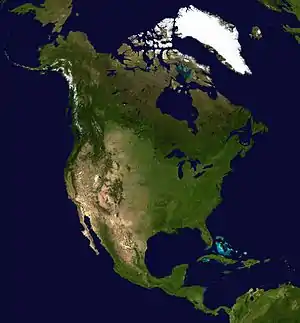Turtle Island (Native American folklore)
Turtle Island is a name for the Earth[1] or for North America, used by some Native American and First Nations people and by some Indigenous rights activists. The name is based on a common North American Indigenous creation story.

Lenape
The Lenape story of the "Great Turtle" was first recorded by Europeans between 1678 and 1680 by Jasper Danckaerts. The story is shared by other Northeastern Woodlands tribes, notably those of the Iroquois Confederacy.[2]
Iroquois
According to Iroquois oral tradition, "the earth was the thought of [a ruler] of a great island which floats in space [and] is a place of eternal peace."[3] Sky Woman fell down to the earth when it was covered with water, or more specifically, when there was a "great cloud sea".[1] Various animals tried to swim to the bottom of the ocean to bring back dirt to create land. Muskrat succeeded in gathering dirt,[1] which was placed on the back of a turtle. This dirt began to multiply and also caused the turtle to grow bigger. The turtle continued to grow bigger and bigger and the dirt continued to multiply until it became a huge expanse of land.[1][4][5] Thus, when Iroquois cultures refer to the earth, they often call it Turtle Island.[5]
According to Converse and Parker, the Iroquois faith shared with Hinduism and other religions the "belief that the earth is supported by a gigantic turtle"[1] In the Seneca language, the mythical turtle is called Hah-nu-nah,[1] while the name for an everyday turtle is ha-no-wa.[6]
Indigenous rights activism and environmentalism
The name Turtle Island is used today by many Indigenous and First Nations cultures, and activists, especially since the 1970s when the term came into wider usage.[7]
The term has also become popular among non-Native environmental activists. American author and ecologist Gary Snyder uses the term to refer to North America, writing that it synthesizes both indigenous and colonizer cultures, by translating the indigenous name into the colonizer's languages (the Spanish "Isla Tortuga" being proposed as a name as well). Snyder argues that understanding North America under the name of Turtle Island will help shift conceptions of the continent.[8]
Influence
The term has been used by writers and musicians, including Gary Snyder, for his Pulitzer Prize-winning book of poetry, Turtle Island';, the Turtle Island Quartet jazz string quartet; Tofurky manufacturer Turtle Island Foods; and the Turtle Island Research Cooperative in Boise, Idaho.[9][10]
The Canadian Association of University Teachers has put into practice the acknowledgment of indigenous territory and claims, particularly at institutions located within unceded land or covered by perpetual decrees such as the Haldimand Tract. Certain courses taught at some Canadian universities, as well as a number of student associations and events, convene by making such an acknowledgement, along with references to Turtle Island.[11]
See also
- Turtles in North American Indigenous Mythology
- Aspidochelone
- Abya Yala – a name used by the Guna people and others to refer to the American continent
- Anahuac – Nahuatl name for the historical and cultural region of Mexico
- Aotearoa – the Māori name for New Zealand
- Aztlán – the legendary ancestral home of the Aztec peoples
- Cemanahuac – Nahuatl name used by the Mexica to refer to the larger region beyond their empire, between the Pacific and Atlantic Ocean
- Geographical renaming – the practice of political renaming
- World Turtle
- Zipacna – the Mayan demonic (crocodilian) personification of the earth's crust
References
- Specific
- Converse and Parker 33
- Why the World is on the Back of a Turtle – Miller, Jay; Man, Royal Anthropological Institute of Great Britain and Ireland, New Series, Vol. 9, No. 2 (June, 1974), pp. 306–308, including further references within the cited text)
- Converse and Parker 31-32
- Johansen and Mann 90
- Porter, Tom (2008). And Grandma Said…: Iroquois Teachings, As Passed Down Through the Oral Tradition. Xlibris Corp. pp. 52–53. ISBN 9781436335652.
- Converse and Parker 31
- Encyclopedia of the Haudenosaunee (Iroquois Confederacy). Johansen, Bruce E. (Bruce Elliott), 1950-, Mann, Barbara Alice, 1947-. Westport, Conn.: Greenwood Press. 2000. ISBN 978-1-4294-7618-8. OCLC 154239396.CS1 maint: others (link)
- Barnhill, David Landis (ed. and introd.). 1999. At Home on the Earth: Becoming Native to Our Place: A Multicultural Anthology. (pp. 297–306). Berkeley: University of California Press, xiv, 327 pp.
- n/a, n/a. "Turtle Island Research Cooperative". Turtle Island Cooperative Farm & Research Center. Retrieved 2018-01-21.
- Rasmussen, B. (2017-01-23). "A Return to Roots: New Boise Nonprofit pursues cultivation of earth and mind". turtleislandfrcenter. Retrieved 2018-01-21.
- Canadian Association of University Teachers. "CAUT Guide to Acknowledging Traditional Territory" (PDF). Retrieved 19 April 2017.
- General
- Converse, Harriet Maxwell; Parker, Arthur Caswell. Myth and Legends of the New York State Iroquois. Albany: New York State Museum, 1906.
- Johansen, Bruce Elliott; Mann, Barbara Alice, eds. Encyclopedia of the Haudenosaunee (Iroquois Confederacy) Westpoint, CT: Greenwood Press, 2000. ISBN 0-313-30880-2.